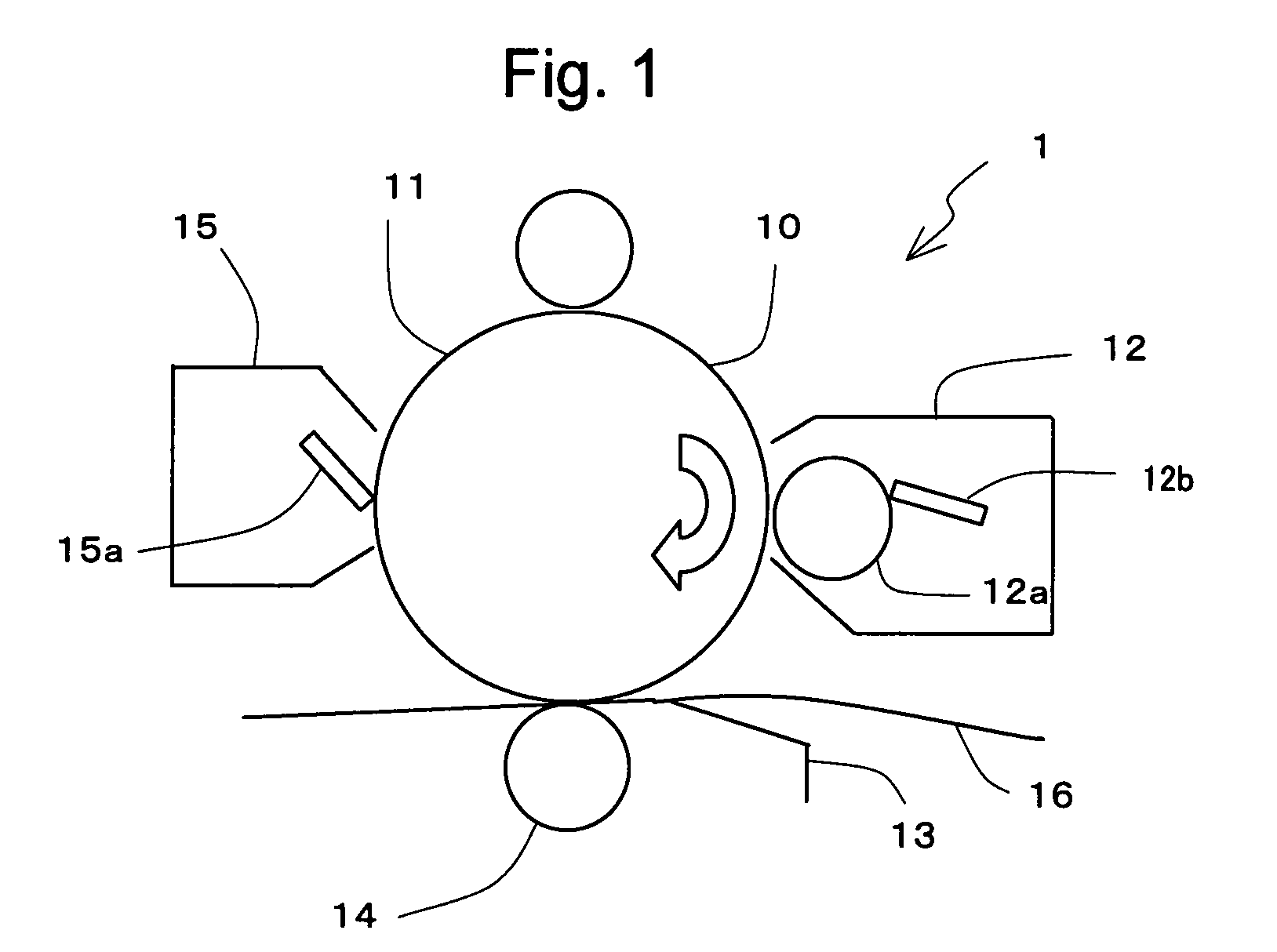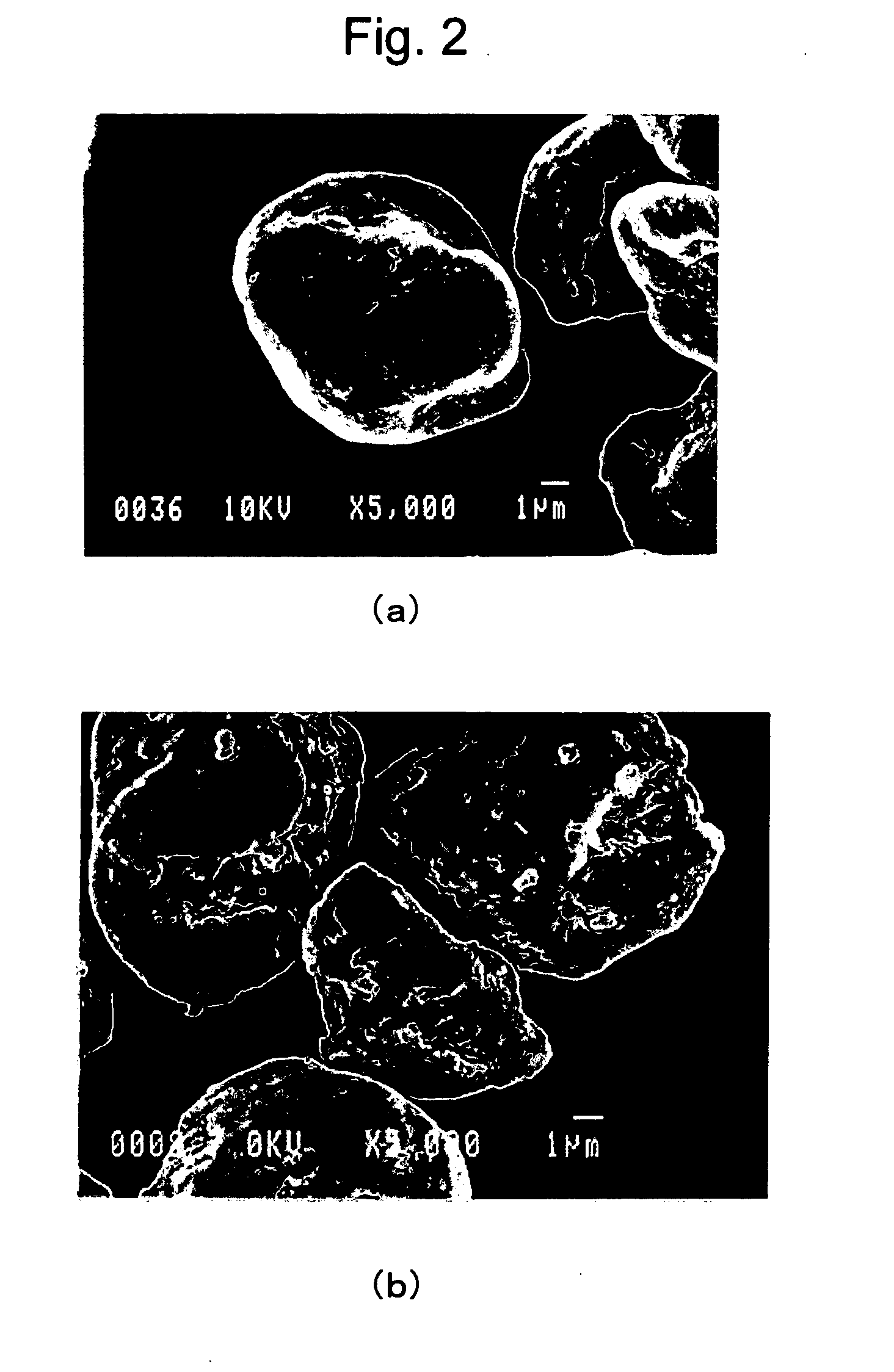Toner for developing electrostatic charge image and image forming method
a technology of electrostatic charge and toner, which is applied in the field of dry-type toner, can solve the problems of low charge supply capability of the carrier, lack of long-term durability, and inability to provide good quality images for a long time, and achieve stable toner thin layer, high image quality, and high durability
- Summary
- Abstract
- Description
- Claims
- Application Information
AI Technical Summary
Benefits of technology
Problems solved by technology
Method used
Image
Examples
example 1
Manufacturing of Toner
[0067] To 49 mass parts of binder resin of styrene acrylic copolymer (47,000 in molecular weight (Mw) (peak 5,000; 931,000), 29.0 in molecular weight distribution (Mw / Mn), 5% in insoluble matter of tetrahydrofuran (THF), 55 in glass transition temperature (Tg)), 45 mass parts of magnetic powder (796 kA / m, 5.0 kA / m in holding power when printing, 82 Am2 / kg in saturation magnetization, 11 Am2 / kg in residual magnetization, and 0.22 μm in number average particle size), 3 mass parts of wax as a release agent (“Sasol Wax H1,” manufactured by Sasol Wax Kabushiki Kaisha), and 3 mass parts of quaternary ammonium salt (“Bontrol P-51,” manufactured by Orient Chemical Kabushiki Kaisha) as a positive charge control agent were added and mixed by a Henshel mixer. The mixture was melt-kneaded by a biaxial extruder, and cooled and then roughly ground by a hammer mill. This was further finely ground by a flow or mechanical grinder, and then classified by a flow classifier, ther...
example 2
[0089] The evaluation tests were conducted in the same manner as in Example 1, except that the developing sleeve was formed of stainless steel, instead of aluminium. The material of the stainless steel was SUS305.
[0090] Firstly, in the same manner as in Example 1, toner roundness and toner particle size distribution were adjusted to obtain the toner particles of Samples Nos. 12 to 22 as shown in Table 4.
TABLE 4MeanRatio of ChargeParticle SizeMeanCharge Amount (μC / g)AmountSample No.(μm)RoundnessOn the drum (D)On the sleeve (S)(D / S)128.50.94012.14.22.9137.20.94010.27.61.3147.80.94513.95.52.5157.80.93912.46.32.0167.80.93611.67.01.7177.80.98010.47.81.3*187.80.93114.67.22.0*197.80.98816.04.04.0*206.80.98813.46.32.1*217.80.9407.88.30.9*227.60.95915.54.63.4
Note) Sample numbers marked with * are not within the scope of the present invention.
[0091] Using the developers of Samples Nos. 12 to 22 shown in Table 4, the evaluations were performed by the same evaluation test, evaluation method...
example 3
[0097] Using the Sample No. 12, the evaluations of the toner thin layer state, initial image density, and leak black spots were conducted by changing the surface roughness Rz of the above developing sleeve formed of the SUS used in Example 2, to the values shown in Table 7, respectively. The toner thin layer state and the initial image density were evaluated in the same manner as in Example 2. The evaluation of leak black spots was as follows. That is, under the environment of normal temperature and normal humidity (20° C. and 55% RH), the printer used in Example 2, KM-50350, was used to output a white image at the initial stage. Then, the evaluation was conducted based on the number of black spots which were present on the white image and had a diameter of 0.1 mm or more. In the evaluation criteria, the case where the number of the black spots was zero was indicated by the symbol “∘”, the case where the number of the black spots was 1 to 4 was indicated by the symbol “Δ”, and the c...
PUM
 Login to View More
Login to View More Abstract
Description
Claims
Application Information
 Login to View More
Login to View More - R&D
- Intellectual Property
- Life Sciences
- Materials
- Tech Scout
- Unparalleled Data Quality
- Higher Quality Content
- 60% Fewer Hallucinations
Browse by: Latest US Patents, China's latest patents, Technical Efficacy Thesaurus, Application Domain, Technology Topic, Popular Technical Reports.
© 2025 PatSnap. All rights reserved.Legal|Privacy policy|Modern Slavery Act Transparency Statement|Sitemap|About US| Contact US: help@patsnap.com


